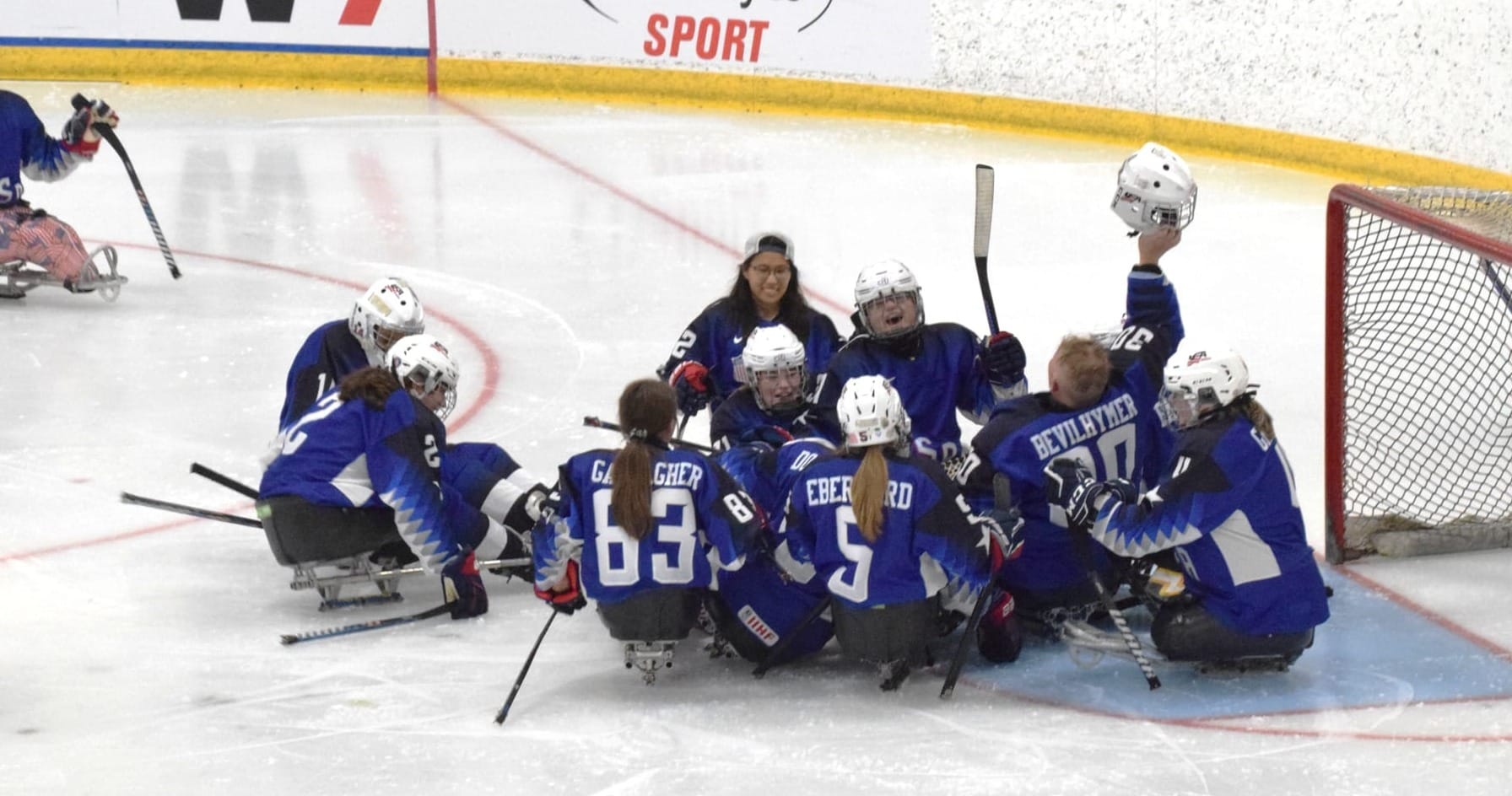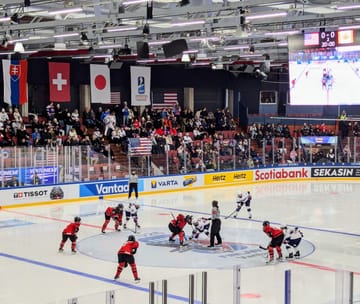There is an ever-present paradox at play when it comes to women’s para ice hockey. In order for the sport to be considered for inclusion in the Paralympics, there have to be more teams.
That means that the women who are currently playing have the burden of creating their own competition.
They would never describe it that way, but that doesn't change the fact that the very best players in the world, who have been left out from co-ed-in-name-only sled hockey at the Paralympics, have not been recognized at the highest level of their sport and have not been offered inclusion in the Paralympics for women's sled hockey because they are too dominant and there aren't enough other sled hockey players and teams across the world.
In 2022, Alex Assi detailed how Canadian Peggy Assinck and others paid for the first women's para camps in England out of their own pockets and how Assnick, while earning her Ph.D, also helped form what is now the Great Britain team.
That same year, I attended inaugural Para Ice Hockey Women's World Challenge where Michelle LaFlamme, World Para Ice Hockey manager, told me, "We could wait for the nations to have their own national teams, or we can help."
Current players who are hoping to reach the pinnacle of their sport are having to grow their game by literally donating equipment and teaching the game to players who then go back to their own countries and look to form a team, receive federation support and eventually play at the international level.
At the 2023 and 2024 Challenges, the North American players sponsored an equipment drive and came to the tournament prepared to outfit players from around the world and send them home with the gear they'd need to start growing the sport back home in their respective countries.
"There’s a constant tension of wanting to win and be the best team while actively helping other countries begin and grow programs and ultimately become their competition," said coach US Rose Misiewicz.
This current, officially named and sanctioned World Championship is a huge step forward for women's hockey, but it's not the ultimate goal. In talking to both Misiewicz and US assistant captain Catherine Faherty, it stood out how much they both spent most of their time talking about the tournament in terms of inspiring new players and new generations to take up the sport.
"It doesn't matter how much we do individually. We can only grow if there are other teams in the world also growing the game and bringing the things they've learned back to their home countries. In standup sports, you don't necessarily help the other teams get better, but in women's sled hockey, that's what we want," said Faherty.
The first international women's sled hockey game took place in 2007. The goal has always been the Paralympics and working towards that has taken up most of the careers of the women on both US and Canada.
The women who keep pushing for recognition for this sport do so at a great personal cost - mentally, physically and monetarily - and yet they continue to do so with compassion, with comeraderie and with joy. They don't resent the need to teach the game to others. On the ice, they are focused and competitive, but off the ice, they give of themselves and have created a welcoming community that fosters friendship and a love of the game.
The unwavering cooperation and commitment and seemingly unending joy the players and coaches have for their sport, for each other and for the future players they haven't even met yet sticks with you. It's impossible not to believe in them, to trust they'll reach their goal because of the passion they so clearly have and the sisterhood they've built with one another.
There have been times, especially for the older players, when the goal of the Paralympics felt impossible and felt really far away. But Misiewicz said reaching sanctioned World Championship status has re-energized the team.
"Reaching this next milestone has energized the group and maybe convinced some of the players and relit the fire to fight through for another four years. This is a commitment and there was a time three or four years ago where I think some of us were thinking, 'Is this ever going to come? What else am I going to do to keep driving this forward?' But now this World Championship has definitely has cast a little bit of new light on the journey," she said.
Just like the stand up teams, the women's sled hockey team spend very little time together as a group throughout the year. Players are responsible for their own fitness and training. While some live in areas where rinks have sled hockey ice time and even teams and leagues, others have to do so individually and often fly out to play in games and tournaments to keep their skills fresh.
Though we rarely talk frankly about it, it's also important to note that these athletes often have more more considerations and needs when traveling, particularly overseas.
To start, countries outside North America tend to be less accommodating to those with disabilities. Cobblestone streets, stairs and even businesses and restaurants that don't accommodate service animals all affect the day to day lives of these athletes as they travel to tournaments or to host clinics.
Additionally, air travel takes more of a toll on these athletes, said Misiewicz. Some will limit their intake for days in advance of flying so they don't have to navigate moving through the airplane and using the facilities. That need is at odds with needing to prepare their body to perform at a high level on the ice. It's a delicate balance, Misiewicz said because their diets are more regimented, they have medications and schedules that are thrown off by international travel. There is nutrition and recovering and physicality and acclimation that all have to be taken into account.
For many of the athletes, the same muscles they use to propel them down the ice, protect the puck and score goals are the ones they have to rely on for mobility once they are off the ice. An injury or overuse or fatigue doesn't just impact their game, it could affect their independence.
The players have careers and jobs and have to use work leave to play for their national teams. The out-of-pocket costs start with equipment, ice time and travel, but extend to nutrition, growing the game for others and the astronomical cost of health care in the US.
And yet, the overwhelming thing you take away from watching, meeting and talking with these players and coaches is their infectious, overwhelming joy.
"The Women's World Challenge was a box that had to be checked to hopefully grow the game so that more and more countries could be present. Now this World Championships is another huge, huge box we have to check in order to make it to the Paralympics and qualify for those games. However, yes, it's a box that just has to be checked, but it's a box that's being checked while we're having fun competing and all enjoying the sport," said Faherty.
But with the fun and enjoyment, Faherty is also constantly thinking about what else she can be doing. How can she be a better teammate or mentor or friend or opponent? Is she supporting her teammates and lifting them up like she hopes someone will do for her after a bad pass or rough shift? Is she answering questions and doing everything she can to make sure the other people and other players are in a position to go home and become better?
"There's always this drive to do more and be better and do as much as we possibly can. It always just seems like it's never enough," said Faherty.
That need to constantly get better is part of what makes Faherty and her teammates the top team in the World, but it can also be exhausting and cause them to miss out on celebrating the things they have done.
Faherty, who started sled hockey at age 5, said she’s also thought a lot about what it means for young girls to see her and her teammates at camps and development events and now get to watch them play at this level on free streams on YouTube.
Team USA as a whole and as individuals have made a massive commitment to not only be world-class athletes, but to be ambassadors for their sport. Faherty said sometimes in the push for the Paralympics, it can be easy to overlook the impact they are making on a day-to-day basis.
“I don’t think about it enough or appreciate it enough, for sure. As much as our team has a goal of making it to the Paralympics, we don't see the small impacts that we’re having on people all over the country. Next week little girls all over the world can watch us online and see how much the sport has grown in the past few years and be motivated. This World Championship is a big deal because none of us had this growing up but now the young girls we coach at camps have a tangible goal to work towards. What we’re doing now is impacting people and we don’t think about that enough,” said Faherty.
“We still have a lot of other milestones to meet, but hopefully this tournament inspires a lot of other women and girls to come out and pick up the sport and keep staying with it.” said Faherty.
Too often conversations around Para athletes center around how "inspiring" they are, making me loathe to use the word in any way with regards to this women. But it's impossible not to be impressed, awed and inspired not by what they are doing physically on the ice, but by their commitment to the community they've created and how they give of themselves on every level to welcome new women into the sport, knowing that one day soon, those same players could be the ones who beat them out for a gold medal or knock them out of a tournament.
Misiewicz and her staff said it's a fine line to balance, but she tries to get the team to be focused on improvement and intensity knowing that every other country is working hard to beat them and that they have given those teams all the tools they need to do it. So they have to continue to push, keep the competition level up and improve every time they get on the ice.
So far, Team USA is 2-0 in the World Championship, with impressive wins over Australia (8-0) and Norway (10-0).
But in the most paradoxical, illogical way, they cannot wait until one of the teams they helped form beats them.
It will be bittersweet and mark the end of an era, but it will also represent a massive milestone for women's sled hockey and be another box checked in their push towards Paralympic inclusion. They'll rue the loss for themselves, but also celebrate with their opponents.
And hopefully, at some point, they'll take a moment to celebrate themselves for all they've accomplished, what they've done for the sport and the lasting legacy they've created for generations to come.
USA has advanced to the semifinals of the World Para Ice Hockey Women’s Championship and will play at 10 A.M. or 1:30 P.M. Eastern on Saturday. The Bronze Medal Game is 10 A.M. Eastern and the Gold Medal Game is 1:30 P.M. Eastern on Sunday.
All games can be viewed for free on the Paralympics YouTube channel.
To learn even more about women's sled hockey, listen to LaFlamme on Sarah Spain's Good Game podcast.



